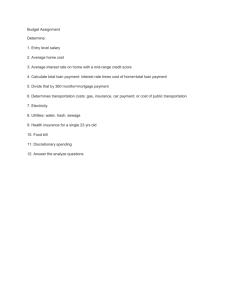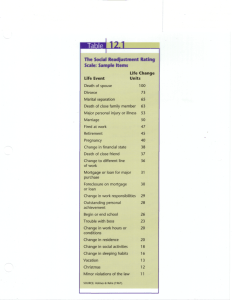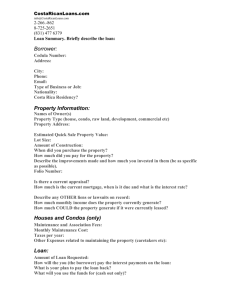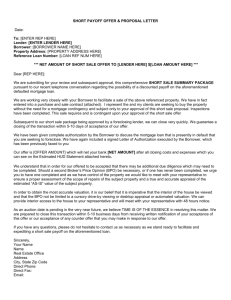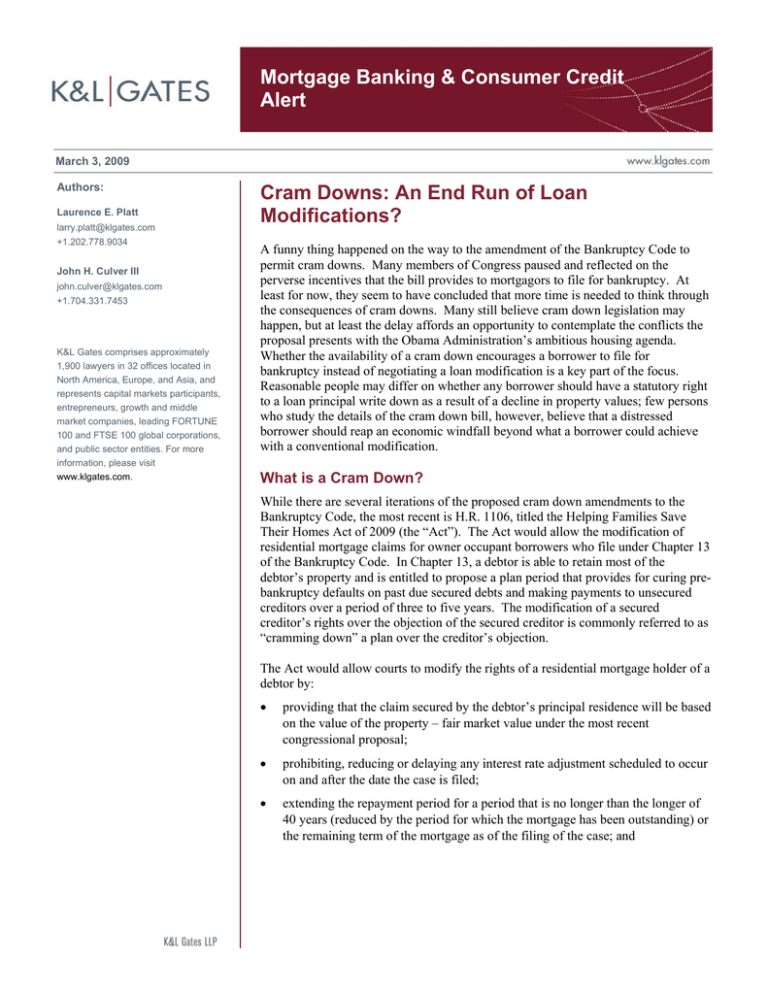
Mortgage Banking & Consumer Credit
Alert
March 3, 2009
Authors:
Laurence E. Platt
larry.platt@klgates.com
+1.202.778.9034
John H. Culver III
john.culver@klgates.com
+1.704.331.7453
K&L Gates comprises approximately
1,900 lawyers in 32 offices located in
North America, Europe, and Asia, and
represents capital markets participants,
entrepreneurs, growth and middle
market companies, leading FORTUNE
100 and FTSE 100 global corporations,
and public sector entities. For more
information, please visit
www.klgates.com.
Cram Downs: An End Run of Loan
Modifications?
A funny thing happened on the way to the amendment of the Bankruptcy Code to
permit cram downs. Many members of Congress paused and reflected on the
perverse incentives that the bill provides to mortgagors to file for bankruptcy. At
least for now, they seem to have concluded that more time is needed to think through
the consequences of cram downs. Many still believe cram down legislation may
happen, but at least the delay affords an opportunity to contemplate the conflicts the
proposal presents with the Obama Administration’s ambitious housing agenda.
Whether the availability of a cram down encourages a borrower to file for
bankruptcy instead of negotiating a loan modification is a key part of the focus.
Reasonable people may differ on whether any borrower should have a statutory right
to a loan principal write down as a result of a decline in property values; few persons
who study the details of the cram down bill, however, believe that a distressed
borrower should reap an economic windfall beyond what a borrower could achieve
with a conventional modification.
What is a Cram Down?
While there are several iterations of the proposed cram down amendments to the
Bankruptcy Code, the most recent is H.R. 1106, titled the Helping Families Save
Their Homes Act of 2009 (the “Act”). The Act would allow the modification of
residential mortgage claims for owner occupant borrowers who file under Chapter 13
of the Bankruptcy Code. In Chapter 13, a debtor is able to retain most of the
debtor’s property and is entitled to propose a plan period that provides for curing prebankruptcy defaults on past due secured debts and making payments to unsecured
creditors over a period of three to five years. The modification of a secured
creditor’s rights over the objection of the secured creditor is commonly referred to as
“cramming down” a plan over the creditor’s objection.
The Act would allow courts to modify the rights of a residential mortgage holder of a
debtor by:
•
providing that the claim secured by the debtor’s principal residence will be based
on the value of the property – fair market value under the most recent
congressional proposal;
•
prohibiting, reducing or delaying any interest rate adjustment scheduled to occur
on and after the date the case is filed;
•
extending the repayment period for a period that is no longer than the longer of
40 years (reduced by the period for which the mortgage has been outstanding) or
the remaining term of the mortgage as of the filing of the case; and
Mortgage Banking & Consumer Credit Alert
•
without clarifying the inherent inconsistency
with the second bullet point above, providing for
the payment of interest at a fixed annual rate
equal to the applicable average prime offer rate
as of the date of the order for relief
corresponding to the selected term, as published
by the Federal Financial Institutions
Examination Council in its table titled “Average
Prime Offer Rates – Fixed,” plus an undefined
reasonable premium for risk.
A cram down is a loan modification turned upside
down. A typical loan modification of the type
proposed by the Federal Deposit Insurance
Corporation (the “FDIC”) starts with a
determination of what the borrower can afford,
subject to a floor, and then determines an affordable
monthly payment through a hierarchy of
alternatives, (i) waiving, capitalizing or forbearing
arrearages, (ii) freezing or reducing the interest rate,
(iii) extending the term, and, as a last resort, (iv)
writing down or forbearing principal. A cram down,
on the other hand, starts with a potentially
permanent write down of principal based solely on
the value of the property, without regard to a
borrower's income. Unlike a typical loan
modification that seeks to minimize the size of a
modification in recognition of the investor’s
interests, neither the debtor nor the bankruptcy judge
would be required (or have statutory authority in the
case of the judge) to limit the size of a cram down to
the amount necessary to produce a long term,
sustainable payment for the borrower. Instead,
principal would be permanently written down
without regard to either the borrower’s need or the
interests of the investor, simply because of a decline
in the real estate value. Moreover, the debtor and
the bankruptcy judge would have considerable
discretion in determining how to value the property,
whether to extend the term and how to treat the
interest rate.
A borrower's income may not determine the size of
the write down but it is relevant to the terms of the
modified mortgage. Under a Chapter 13 plan, a
debtor must commit to pay all of his disposable
income for distribution to creditors for the duration
of the plan, which typically is five years. In order to
qualify for Chapter 13 relief, an individual must
have both a regular source of current monthly
income from which to make predetermined
payments to the bankruptcy trustee for the benefit of
creditors and enough disposable income to make
regular payments to the trustee after covering
current necessary living expenses. The debtor’s
“current monthly income” is determined based on
the average of the debtor’s income from any source
for the six months prior to the filing of the
bankruptcy case. Like a stated income loan, the
borrower certifies the amount of his or her income
but there is no independent verification process.
Moreover, there is no process to ensure that income
from the last six months is reasonably sustainable
over the next six months and beyond. If the
borrower has insufficient income to make that
payment, then the plan cannot be confirmed. If the
plan is not confirmed, no cram down can occur.
It is this primary reliance on property value rather
than on income that leaves the industry scratching
its collective head. Over the last two years, we've
seen federal agencies and instrumentalities promote
loan modifications that seek to balance the interests
of borrowers and investors. The availability of a
cram down seems to undermine these efforts. In a
declining property value market, debtors almost
always will be better off starting with the gift of a
potentially permanent write down of principal to
reflect declines in property values rather than a
modification based on what the debtor can afford to
pay. A borrower who doesn't qualify for a cram
down because of insufficient income most certainly
would not qualify for a loan modification, but,
ironically, a borrower who doesn't qualify for a loan
modification because of insufficient income may
still qualify for a cram down and receive materially
better loan terms than a modification could have
offered. This is the economic windfall to which
commentators refer. Why should a mortgagor
negotiate with a lender for a loan modification when
the mortgagor most likely can get a better deal in
bankruptcy on the mortgage loan and relief from
unsecured debt as well?
Consumer advocates claim that this fear is
unfounded - that borrowers will be dissuaded from
filing for bankruptcy because of the adverse impact
such a filing would have on the borrower's future
ability to obtain a mortgage loan. Even if a debtor's
bankruptcy attorney would so advise a borrower,
this assumes that borrowers with troubled credit can
qualify for residential mortgage loans. Furthermore,
March 2009
2
Mortgage Banking & Consumer Credit Alert
by the time many borrowers seek bankruptcy advice,
their credit is too impaired for conventional lenders.
Maybe we're missing something, but last we
checked there appears to be no credit available for
borrowers with subprime credit histories. The Hope
for Homeowners Program, if it is restructured, might
provide some opportunities, but right now the hope
is illusory. It is hard to believe that a borrower
would refrain from filing for bankruptcy for fear of
being unable to obtain credit that probably is not
available anyway.
Is a Cram Down Permanent?
A cram down is not necessarily permanent. If a case
is dismissed or converted before plan payments are
completed and the debtor receives a discharge, a
secured lender whose claim was modified continues
to retain its lien to the extent recognized by
applicable non bankruptcy law. The literal
application of this provision in the context of the
proposed bill would appear to mean that, if a
Chapter 13 case is dismissed or converted after cram
down (and before the debtor completes plan
payments and receives a discharge), the creditor’s
rights revert to those that existed as of the date of the
petition. If the default occurs after the discharge of
the plan, the holder's lien would not revert to the
pre-bankruptcy amount.
The reversion to the pre-bankruptcy status quo will
not be automatic. The courts will retain substantial
discretion to determine the consequences of a
debtor’s default; and the courts are likely to continue
to provide debtors with opportunities to cure those
defaults prior to imposing the sanctions of
conversion, dismissal or relief from stay. Yet, in
many cases, the filing of the Chapter 13 case and a
proposed mortgage modification may only delay the
ultimate foreclosure of the property rather than avoid
it entirely. Even with mortgage modification, it is
possible that a large portion of Chapter 13 cases will
continue to result in either dismissal or conversion to
Chapter 7 because the debtor will be unable to make
the payments required under the plan for the entire
plan period.
Under the most recent version of the proposed Act,
the original lien effectively could be partially
reinstated if the debtor sells the principal residence
before receiving a discharge. The Act provides a
shared appreciation feature on a four-year sliding
scale, with the creditor in the first year entitled to
eighty percent of the difference between the sales
price and the new crammed down principal balance
(plus costs of sale and improvements) up to the
amount of the allowed secured claim determined as
if a cram down had not occurred. This amount
reduces by twenty percent in each of the next four
years. Imagine the joy of the bankruptcy judges
who presumably will have to determine what
improvements are in and out of the calculation of
the amount due to the lien holder without the benefit
of a detailed set of guidelines to control this process.
(An interesting question is whether this shared
appreciation feature will apply to sales resulting
from foreclosures.)
Does a Cram Down Void the Loan?
No and yes. As noted above, a cram down
bifurcates a qualifying residential mortgage loan
into two parts: the secured portion based on the
value of the property securing the loan and the
crammed down unsecured portion. The unsecured
portion is not voided at the time of a cram down. If
a debtor performs in accordance with the approved
bankruptcy plan, however, the unsecured portion
evaporates at the time the debtor’s debts are
discharged at the end of the plan.
The Act proposes a curious circumstance that
effectively would void the loan at the time of plan
confirmation for mortgage loans subject to the Truth
in Lending Act (“TILA”). The remedy does not
appear to be dependent on a cram down. The Act
would disallow a creditor's claim in bankruptcy for
an owner-occupied home loan that “is subject to a
remedy for rescission under TILA notwithstanding
the prior entry of a foreclosure judgment….” Why
this provision exists and how it would work is
anything but clear.
TILA provides the extraordinary remedy of
rescission for certain types of violations. When a
loan is rescinded, the holder has to take steps to
release the security interest and, subject to certain
limited exceptions, give back to the mortgagor all
amounts paid by the mortgagor, even if the
payments went to third parties like mortgage
brokers and settlement service providers. In turn,
the mortgagor has to return the principal received
from the creditor. Rescission does not void the loan
per se, but it is designed to put the parties back into
March 2009
3
Mortgage Banking & Consumer Credit Alert
the position they were before the borrower obtained
a loan in the first place. A borrower may only bring
a rescission claim for three years after the loan is
consummated.
As written, the Act would provide yet another
example of a better deal for the borrower in
bankruptcy. If the borrower pursued the remedy of
rescission in a TILA case outside of the bankruptcy
process, the borrower would be limited to the
explicit statutory remedies provided in TILA. If the
borrower pursued the same case within the
bankruptcy process, the borrower could avoid
repaying anything under the loan, a result that TILA
does not contemplate. This is another perverse
economic incentive for a borrower to file bankruptcy
to get a financial windfall not available outside of
bankruptcy. We can think of no justification that
would entitle a borrower to obtain a better remedy
for a TILA violation based solely on whether the
borrower filed for bankruptcy.
Who is Eligible for a Cram Down?
As noted above, borrowers must have sufficient
income to qualify for a cram down, but that is not
the only eligibility requirement. First, only debtors
who have received a notice that foreclosure may be
commenced prior to the filing of the bankruptcy case
would be entitled to this relief. In other words, a
borrower who is current on a mortgage loan, but in
default on other obligations could file for bankruptcy
protection but not take advantage of these
modification provisions. It is not clear under the
proposed amendments whether the notice of
potential foreclosure is nothing more than a
delinquency notice where the possibility of
foreclosure is mentioned or the last delinquency
notice prior to the filing for foreclosure.
Second, the proposed amendments pay lip service to
the concern that borrowers should not be able to
circumvent the process of negotiating loan
modifications with their lenders. Under the
proposed amendments, the mortgagor is not eligible
for a cram down absent a certification that the
mortgagor attempted at least fifteen days before the
filing for bankruptcy to contact the loan holder or
loan servicer regarding modification of the loan.
Cynics call this the “voice mail exception.” A
borrower only has to leave a voice mail with the
loan servicer regarding a loan modification to be
eligible; the borrower does not have to take the
returned call from the loan servicer, provide
financial information to the servicer or engage in
meaningful discussions. Contrast this with the
Homeowner Affordability and Stability Plan
proposed by the Obama administration on February
27, 2009 (the “Obama Plan”), which states that
cram downs should be eligible “when families run
out of other options.” It requires homeowners first
to ask their loan servicers or loan holders for a loan
modification and certify that they have complied
with reasonable requests from the servicer to
provide essential information. Even the Obama
Plan, however, does not require a borrower to
accept a modification proposed by the servicer that
has been determined in accordance with the Obama
Plan. Nor does it disqualify a homeowner for a
cram down following a loan servicer's turndown of
a loan modification after careful consideration of
the homeowner's financial circumstances.
Some in Congress have touted cram downs as a
forced alternative to recalcitrant loan servicers or
loan holders who would not seriously consider loan
modification--a sort of “you can pay me now or you
can pay me more later” threat. It is one thing to
argue that a homeowner should not be denied a loan
modification that meets the criteria of a federally
promulgated uniform plan. It is quite another to
argue that the homeowner should get a better deal.
What Loans are Eligible for a Cram
Down?
Investor loans and non-owner-occupant loans
already are subject to cram down under the
Bankruptcy Code. All of the competing
congressional proposals, as well as Obama’s Plan,
extend the availability of cram downs to owneroccupied home loans. Beyond that, though, there is
substantial disagreement as to product type, date of
origination, date of claim, and loan size.
Some believe that, if cram downs are permitted at
all, they should be limited to subprime and nontraditional mortgage loans, such as hybrid ARMs,
payment option ARMs and interest only ARMs.
The theory in part is that perhaps these loans never
should have been made in the first place or, if at all,
on materially different loan terms, such as with
lower principal balances that a verified income
could have supported. Moreover, these loans are
March 2009
4
Mortgage Banking & Consumer Credit Alert
the most likely to be found in private label mortgage
backed securities where the complexities of the
securitization documents have impaired the ease of
loan modifications.
Others argue that there is no reason a veteran
borrower of a VA-guaranteed loan or a first time
homebuyer under a FHA-insured loan or any other
borrower for that matter should be ineligible for a
cram down. Well, we can think of one. In the case
of FHA-insured, VA-guaranteed or GSE-owned or
guaranteed, the federal government has the ability to
determine the standards for loan modifications.
There are no concerns about the risk of invisible or
ornery investors who simply refuse to play the loan
modification game.
The proposed amendments limit cram downs to
loans originated before the effective date of the new
law. Some assert this should be further limited to
loans that were originated during the height of the
subprime crisis, such as loans originated between
2004 and 2007. Some assert that there should be a
“drop dead” date by which a homeowner must file
for bankruptcy, so there is some certainty about the
size of the overhang of cram down claims.
The Obama Plan limits the outstanding principal
balance of loans eligible for a cram down to the
Fannie Mae/Freddie Mac conforming loan limits “so
that millionaire homes don't clog the bankruptcy
courts.”
Who Bears the Costs of a Cram Down?
There are three potential direct victims of a cram
down in terms of who ultimately pays for the cram
down: the loan servicer, the loan or MBS holder or
the federal government. Which one loses depends
on the type of loan (e.g., conventional versus FHAinsured or VA-guaranteed), the manner in which the
loan is held (e.g., as a whole loan or as a mortgage
backed security), the terms of the servicing
agreement (e.g., scope of advance and repurchase
obligations), and, if securitized, the type of
securitization (e.g., private label, agency). Newer
versions of the Act seek to revise who bears the risk
of loss.
Securities holders appear to bear the ultimate credit
risk of loss in private label mortgage backed
securities transactions. Which class of investor
bears this risk depends on the terms of the deal
documents. If and to the extent these securities are
held for investment by banks and other financial
institutions, they face the risk of downgrades of the
securities by the rating agencies and a concomitant
drop in market value that will have to be reflected
on the balance sheets and may result in capital
impairment. At the very time that the government is
trying to shore up the balance sheets of America's
depository institutions, Congress is contemplating
bankruptcy provisions that could undermine that
effort.
Interestingly, the Act now proposes to trump certain
of the provisions of existing private mortgage
backed securities transactions by rendering
unenforceable provisions that require excess
bankruptcy losses exceeding a certain dollar amount
to be borne by specified classes of certificates on a
pro rata basis. In other words, MBS investors may
have signed up to bear special bankruptcy losses but
the losses will be limited to the kind that investors
reasonably could have contemplated incurring at the
time the investors purchased the securities. This
change would not transfer the risk of a cram down
loss away from the securities holders per se; it
merely would reallocate the risk of loss from one
class of securities holders who originally had
contracted to assume this risk to those who had not.
In determining the reasonable expectations of
investors at the time they bought the securities, note
that many consumer organizations have long
advocated expanding cram downs to owneroccupied loans.
Fannie Mae and Freddie Mac clearly bear the risk of
cram down loss on the loans they hold in portfolio
and appear to bear the risk of loss on mortgage
backed securities that they guaranty. This, of
course, means that the American taxpayers
ultimately bear this risk of loss, but without the need
for a specifically contemplated Congressional
appropriation to subsidize the financial cost of cram
downs; the true cost, therefore, lacks transparency.
Moreover, the GSE's obligation to repurchase
crammed down loans from the pools on securities
they guarantee will impact their ability to purchase
other loans given the regulatory restrictions on the
size of their mortgage investments.
March 2009
5
Mortgage Banking & Consumer Credit Alert
In the case of mortgage backed securities guaranteed
by the Government National Mortgage Association,
it appears that the servicer or issuer, and not the
securities holders, may bear the initial risk of loss, as
a result of their obligation to use their own funds to
repurchase the modified loans from the pools
backing the Ginnie Mae securities.
The federal government also might bear the ultimate
credit risk of loss on FHA-insured and RHS- and
VA-guaranteed loans that the issuers repurchase
from the Ginnie Mae pools. Under existing rules,
the federal government's insurance and guaranty
programs do not cover principal and interest losses
resulting from cram downs. With certain variations,
the proposed Act, however, authorizes the agencies
to insure or guaranty against this risk of loss either
by giving the agency direct authority to accept an
assignment of the crammed down loan in exchange
for insurance or guaranty benefits based on the loan
as if no cram down had occurred, to accept a partial
claim for the unsecured portion of a mortgage loan
as a result of a cram down or to include the amount
of a cram down in the calculation of guaranty
benefits. This, of course, helps the Ginnie Mae loan
servicer who had to buy the modified loan out of the
Ginnie Mae pool, which is very important to the
continued viability of the Ginnie Mae program. Yet,
as with Fannie Mae and Freddie Mac, the approach
essentially imposes the risk of cram down loss on
the federal government without a transparent
accounting of the true cost of cram downs.
And loan servicers do not get off scott free. Even if
they can assign a loan repurchased from a Ginnie
Mae pool back to FHA or VA, the loan servicers
initially have to use their funds to make advances
prior to the confirmation of the bankruptcy plan and
to effect the loan repurchase. On the private label
side, the loan servicer may not have to repurchase
the loans, but they may be required to make
advances for a significant period of time in an
environment where servicer advance credit lines are
all but non-existent.
How Should the Proposed Act be
Amended?
We leave to economists the question of whether the
adoption of the Act to permit cram downs will have
a long term negative effect on the cost of the credit.
For this purpose, we assume for the sake of
argument that Congress intends to enact a version of
the Act and we provide the following general
suggestions:
1. Limit loan types that are available for cram
down. Underlying the Act is the apparent belief
that servicers are not modifying loans fast
enough or deep enough because of investor
restrictions under servicing agreements.
Perhaps the risk of cram downs will force the
hand of servicers to modify, the argument goes.
This underlying premise makes no sense with
respect to loans either insured or guaranteed by
the FHA or VA or purchased or securitized by
Fannie Mae and Freddie Mac. In these cases,
the identity of the decision maker on
modifications is evident, and the federal
government can not reasonably be accused of
an unwillingness to promote loan modifications.
If FHA/VA/RHS loans must be available for
cram down, it is essential that the insurance or
guarantee of those loans covers the amount of
any cram down, enabling servicers to swap the
loans or the unsecured portions for insurance or
guaranty benefits.
2. Don't reward borrowers who refuse to
cooperate in the modification proposal process.
In many cases the servicers are ready, willing
and able to modify loans to provide borrowers
with long term, sustainable payments, but the
borrowers refuse to respond to phone calls and
letters from the servicers. A borrower should
not be eligible for a cram down if there is
written evidence that the lender sought to
engage the borrower in loan modification
discussions but the borrower chose not to
respond, merely left a voicemail or refused to
accept a reasonable modification package in
search of a better deal. Evidence that the
servicer provided the borrower with a written
modification proposal within a reasonable
number of days of the filing for bankruptcy that
is based on information provided by the
borrower and that is on terms consistent with a
government promoted loan modification plan
should be sufficient for this purpose.
3. Don't give borrowers an economic windfall. By
focusing first on the value of the property rather
than the borrower's ability to repay, a cram
down could provide borrowers with materially
March 2009
6
Mortgage Banking & Consumer Credit Alert
better economic terms than would result from
the application of other government proposed
modification standards, such as those of the
FDIC or under the Obama Plan. It makes no
sense to give a borrower in bankruptcy a better
deal than the government would offer a
defaulting borrower who is not in bankruptcy.
Such an action completely undermines the
efforts of the Administration to promote loan
modifications.
4. Balance the interests of borrowers and holders.
There are virtually no standards to guide a
bankruptcy judge in determining the particulars
of a cram down. If requested by an eligible
debtor, the judge must reduce the loan to the
property value, for example, even if the size of
the write down is not necessary given the
borrower's current income. Similarly, the
reduction of the interest rate or the extension of
the term may not be necessary to enable the
borrower to achieve an affordable payment. Yet
a cram down is a zero sum proposition--what
one gives to the debtor through a cram down
one takes from the loan holder or other
interested party. An overarching standard
should be imposed that limits the size of any
cram down to that which is reasonably
necessary to achieve long term affordability. In
this regard, Congress alone should define the
phrase “reasonable risk premium” so judges
have an objective standard to apply in
determining the loan’s interest rate.
5. Don't expand the remedies for TILA violations
under the guise of a cram down. Bankruptcy
judges already have the legal authority to
adjudicate claims by borrowers that the home
loan violates applicable consumer credit law and
provide the remedies that are available under
that law. The amendment needlessly increases
the remedies that are available to the borrower
simply because the borrower filed for
bankruptcy. Not only does this encourage the
filing for bankruptcy to get a better deal, but
there is no rational justification to increase the
remedies for consumer credit violations solely
as a result of a bankruptcy filing.
6. Don’t increase the toxicity levels of tainted
mortgage backed securities held by financial
institutions. As noted above, private label
mortgage backed securities could be
downgraded by rating agencies as a result of the
adoption of the Act because of the greater credit
losses that are predicted to be borne by the
securities holders. This will result in a material
decline in book value and potential capital
impairment to the financial institutions that hold
the paper. Seeking to eliminate this risk by
nullifying the negotiated provisions of private
contracts is a slippery slope.
7. Disclose the true cost of cram downs. If
Congress so desired, it could appropriate direct
subsidies to distressed borrowers to help them
with their underwater mortgages, just like the
government now provides food stamps,
unemployment benefits and Medicaid or
Medicare to individuals in need. Directing
cram down losses to be incurred through
FHA/VA/RHS/Fannie Mae/Freddie Mac masks
the true cost of cram downs to the federal
government, by lumping the losses with general
operating losses of the agencies or their
insurance funds. This enables the federal
government to avoid the hard task of evaluating
the wisdom of the “spend.”
*
*
*
The recent pause by Congress in considering the
enactment of the Act provides an opportunity to get
beyond the simple appeal of cram downs to reflect
on the natural consequences of cram downs. First,
somebody has to pay for the economic
consequences of a cram down; there is no such
thing as a free cram down, although the debtor
certainly can reap an economic windfall for which
somebody has to pay. Whether the ultimate credit
risk of loss is borne indirectly by the federal
government or directly by private loan holders and
securities holders, the cost is real but not
transparent. Second, because the borrower can get a
better deal in bankruptcy, the availability of cram
downs materially undermines the federal
government’s considerable continuing initiative to
promote loan modifications. If, however, Congress
is determined to provide distressed borrowers with
the tool of cram downs, perhaps it will do it in a
way that minimizes the financial costs to third
parties and maximizes the alternative loss mitigation
strategy of loan modifications.
March 2009
7
Mortgage Banking & Consumer Credit Alert
K&L Gates’ Mortgage Banking & Consumer Credit practice provides a comprehensive range of
transactional, regulatory compliance, enforcement and litigation services to the lending and settlement
service industry. Our focus includes first- and subordinate-lien, open- and closed-end residential mortgage
loans, as well as multi-family and commercial mortgage loans. We also advise clients on direct and indirect
automobile, and manufactured housing finance relationships. In addition, we handle unsecured consumer
and commercial lending. In all areas, our practice includes traditional and e-commerce applications of
current law governing the fields of mortgage banking and consumer finance.
For more information, please contact one of the professionals listed below.
LAWYERS
Boston
R. Bruce Allensworth
Irene C. Freidel
Stephen E. Moore
Stanley V. Ragalevsky
Nadya N. Fitisenko
Brian M. Forbes
Andrew Glass
Phoebe Winder
Charlotte
John H. Culver III
Los Angeles
Thomas J. Poletti
Miami
Paul F. Hancock
New York
Philip M. Cedar
Elwood F. Collins
Steve H. Epstein
Drew A. Malakoff
San Francisco
Jonathan Jaffe
Erin Murphy
Seattle
Holly K. Towle
Washington, D.C.
Costas A. Avrakotos
Melanie Hibbs Brody
Daniel F. C. Crowley
Eric J. Edwardson
Anthony C. Green
Steven M. Kaplan
Phillip John Kardis II
Rebecca H. Laird
Laurence E. Platt
Phillip L. Schulman
Ira L. Tannenbaum
Nanci L. Weissgold
Kris D. Kully
Morey E. Barnes
bruce.allensworth@klgates.com
irene.freidel@klgates.com
stephen.moore@klgates.com
stan.ragalevsky@klgates.com
nadya.fitisenko@klgates.com
brian.forbes@klgates.com
andrew.glass@klgates.com
phoebe.winder@klgates.com
+1.617.261.3119
+1.617.951.9154
+1.617.951.9191
+1.617.951.9203
+1.617.261.3173
+1.617.261.3152
+1.617.261.3107
+1.617.261.3196
john.culver@klgates.com
+1.704.331.7453
thomas.poletti@klgates.com
+1.310.552.5045
paul.hancock@klgates.com
+1.305.539.3378
phil.cedar@klgates.com
elwood.collins@klgates.com
steve.epstein@klgates.com
drew.malakoff@klgates.com
+1.212.536.4820
+1.212.536.4005
+1.212.536.4830
+1.216.536.4034
jonathan.jaffe@klgates.com
erin.murphy@klgates.com
+1.415.249.1023
+1.415.249.1038
holly.towle@klgates.com
+1.206.370.8334
costas.avrakotos@klgates.com
melanie.brody@klgates.com
dan.crowley@klgates.com
eric.edwardson@klgates.com
anthony.green@klgates.com
steven.kaplan@klgates.com
phillip.kardis@klgates.com
rebecca.laird@klgates.com
larry.platt@klgates.com
phil.schulman@klgates.com
ira.tannenbaum@klgates.com
nanci.weissgold@klgates.com
kris.kully@klgates.com
morey.barnes@klgates.com
+1.202.778.9075
+1.202.778.9203
+1.202.778.9447
+1.202.778.9387
+1.202.778.9893
+1.202.778.9204
+1.202.778.9401
+1.202.778.9038
+1.202.778.9034
+1.202.778.9027
+1.202.778.9350
+1.202.778.9314
+1.202.778.9301
+1.202.778.9215
March 2009
Mortgage Banking & Consumer Credit Alert
David L. Beam
Emily J. Booth
Holly Spencer Bunting
Krista Cooley
Elena Grigera
Melissa S. Malpass
David G. McDonough, Jr.
Stephanie C. Robinson
Kerri M. Smith
David Tallman
Directorof Licensing
Washington, D.C.
Stacey L. Riggin
david.beam@klgates.com
emily.booth@klgates.com
holly.bunting@klgates.com
krista.cooley@klgates.com
elena.grigera@klgates.com
melissa.malpass@klgates.com
david.mcdonough@klgates.com
stephanie.robinson@klgates.com
kerri.smith@klgates.com
david.tallman@klgates.com
+1.202.778.9026
+1.202.778.9112
+1.202.778.9853
+1.202.778.9257
+1.202.778.9039
+1.202.778.9081
+1.202.778.9207
+1.202.778.9856
+1.202.778.9445
+1.202.778.9046
stacey.riggin@klgates.com
+1.202.778.9202
RegulatoryComplianceAnalysts
Washington, D.C.
Dameian L. Buncum
dameian.buncum@klgates.com
Teresa Diaz
teresa.diaz@klgates.com
Jennifer Early
jennifer.early@klgates.com
Robin L. Gieseke
robin.gieseke@klgates.com
Allison Hamad
allison.hamad@klgates.com
Joann Kim
joann.kim@klgates.com
Brenda R. Kittrell
brenda.kittrell@klgates.com
Dana L. Lopez
dana.lopez@klgates.com
Patricia E. Mesa
patty.mesa@klgates.com
Jeffrey Prost
jeffrey.prost@klgates.com
+1.202.778.9093
+1.202.778.9852
+1.202.778.9291
+1.202.778.9481
+1.202.778.9894
+1.202.778.9421
+1.202.778.9049
+1.202.778.9383
+1.202.778.9199
+1.202.778.9364
K&L Gates comprises multiple affiliated partnerships: a limited liability partnership with the full name K&L Gates LLP qualified in Delaware and
maintaining offices throughout the U.S., in Berlin and Frankfurt, Germany, in Beijing (K&L Gates LLP Beijing Representative Office), and in
Shanghai (K&L Gates LLP Shanghai Representative Office); a limited liability partnership (also named K&L Gates LLP) incorporated in England and
maintaining our London and Paris offices; a Taiwan general partnership (K&L Gates) which practices from our Taipei office; and a Hong Kong
general partnership (K&L Gates, Solicitors) which practices from our Hong Kong office. K&L Gates maintains appropriate registrations in the
jurisdictions in which its offices are located. A list of the partners in each entity is available for inspection at any K&L Gates office.
This publication is for informational purposes and does not contain or convey legal advice. The information herein should not be used or relied upon
in regard to any particular facts or circumstances without first consulting a lawyer.
©2009 K&L Gates LLP. All Rights Reserved.
March 2009

